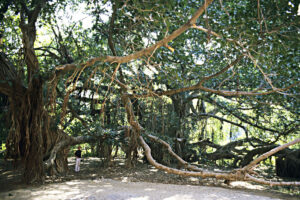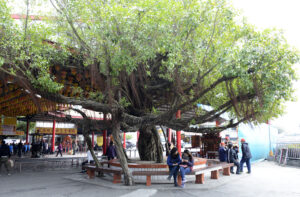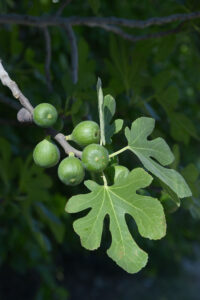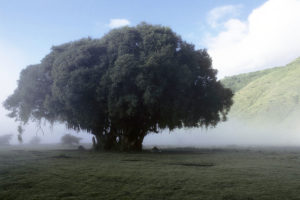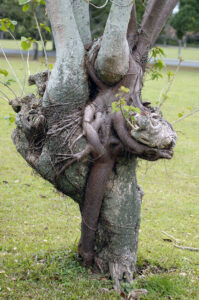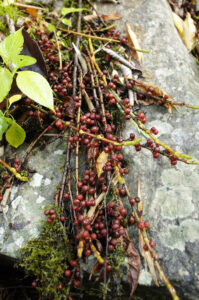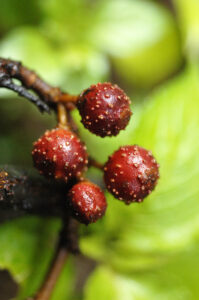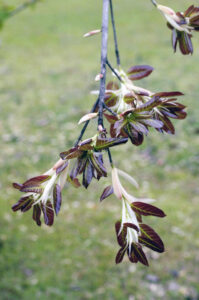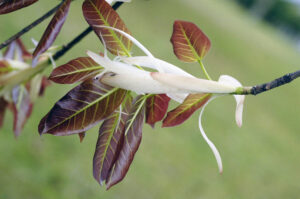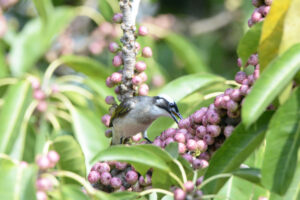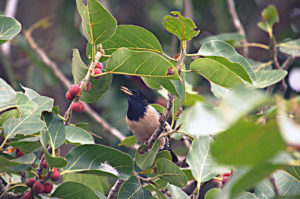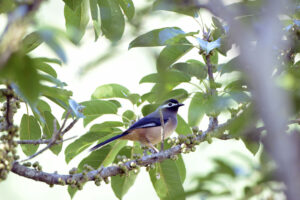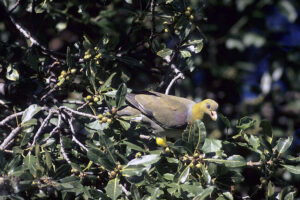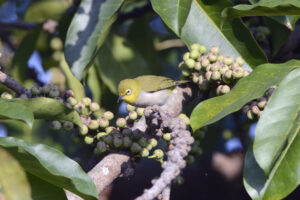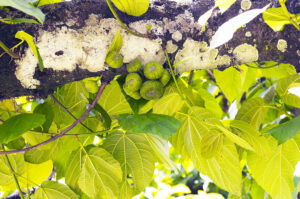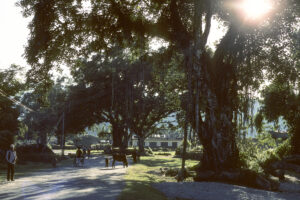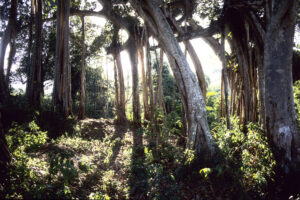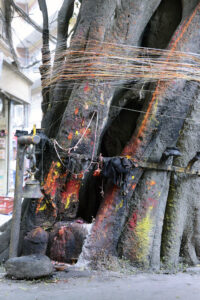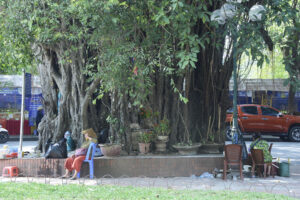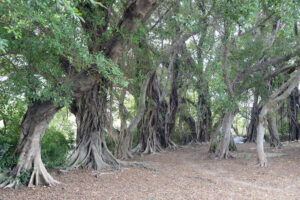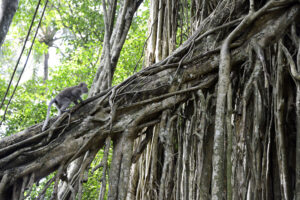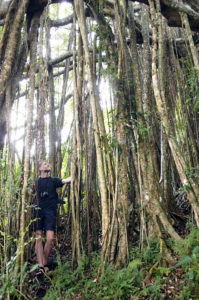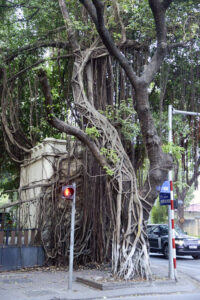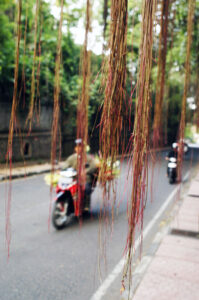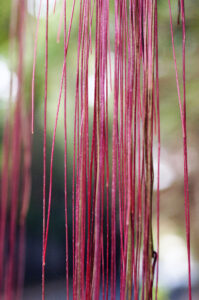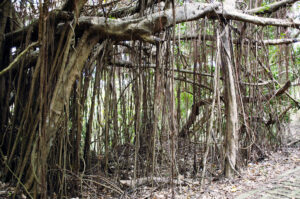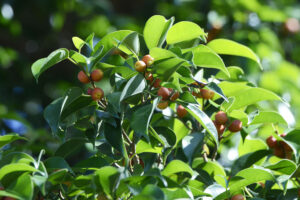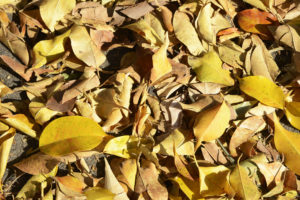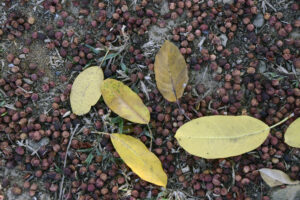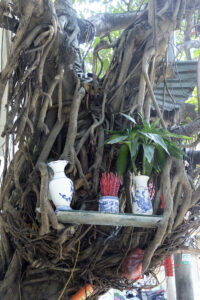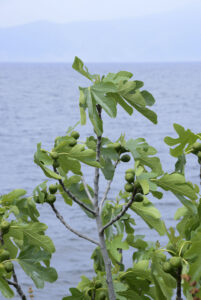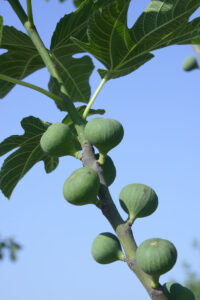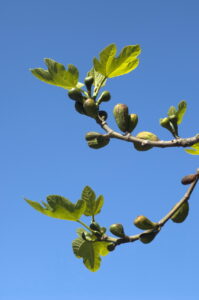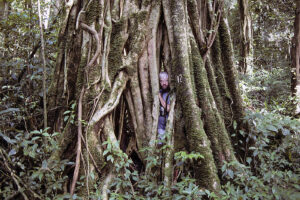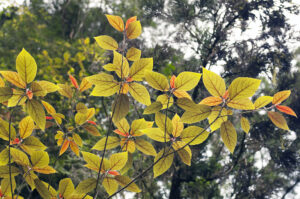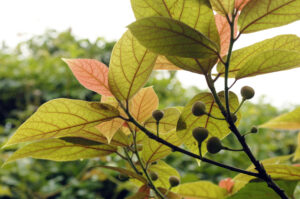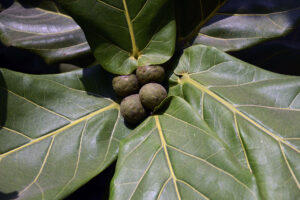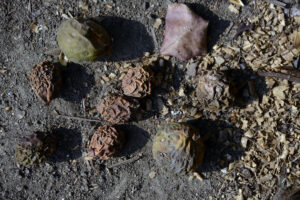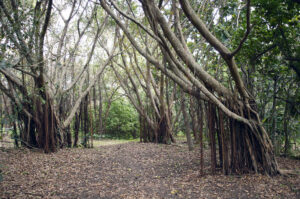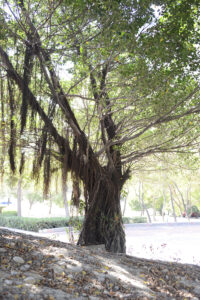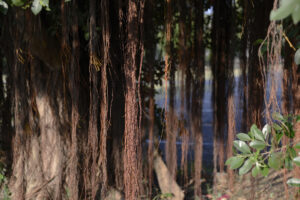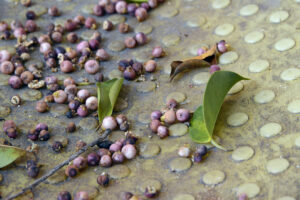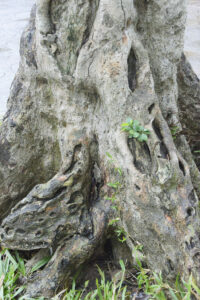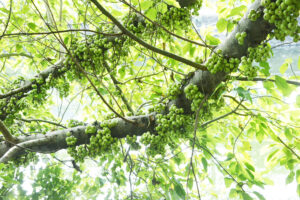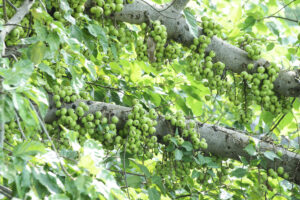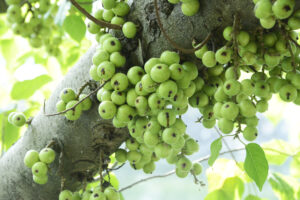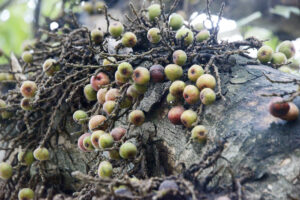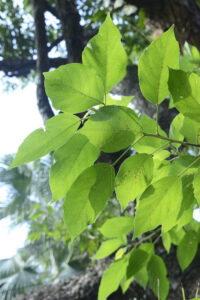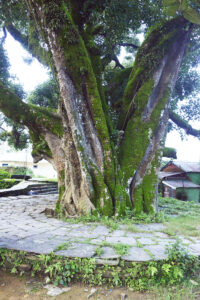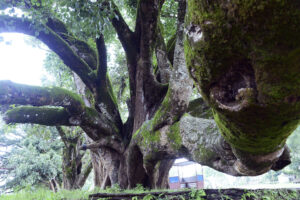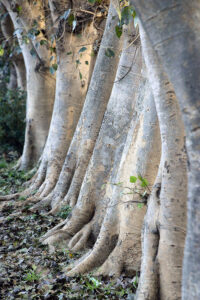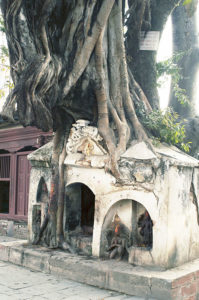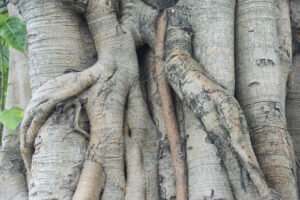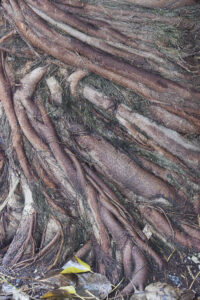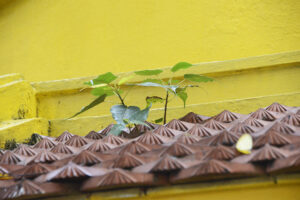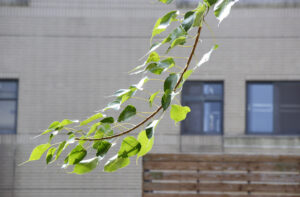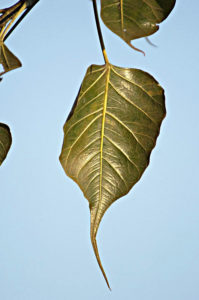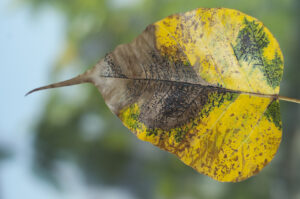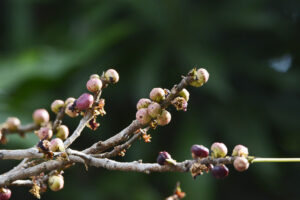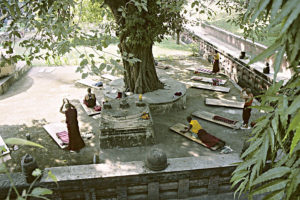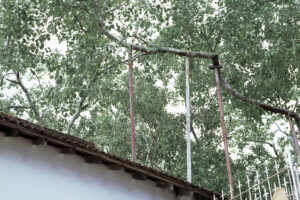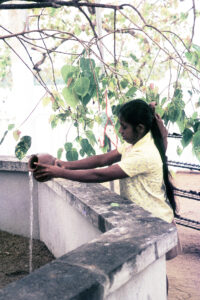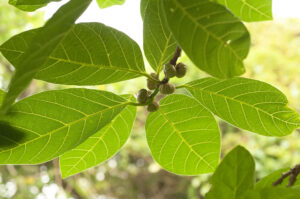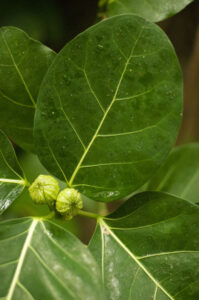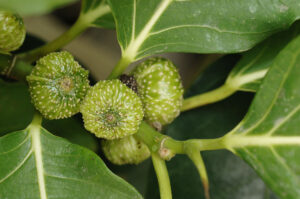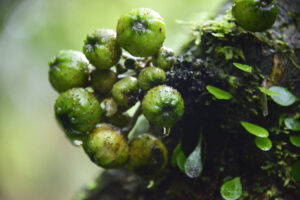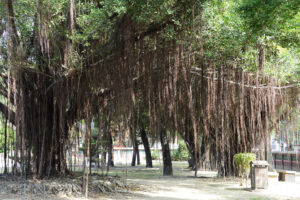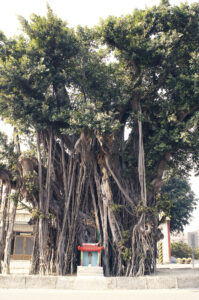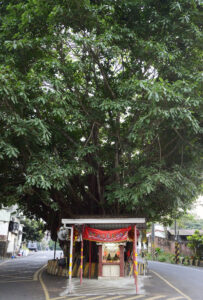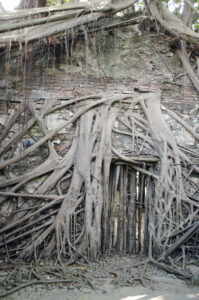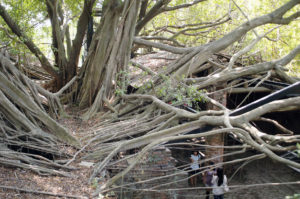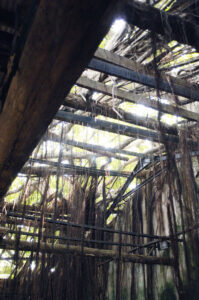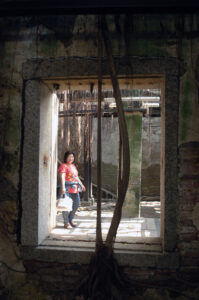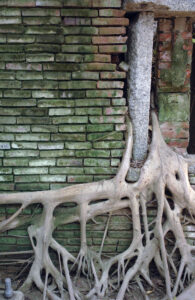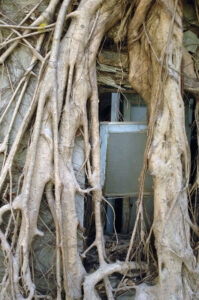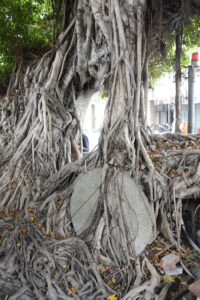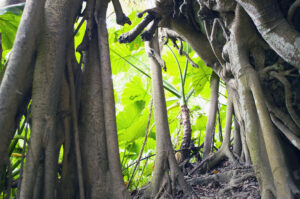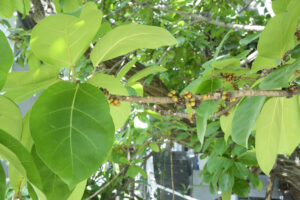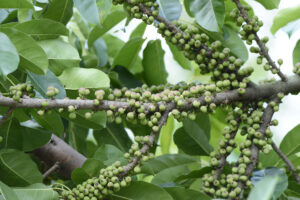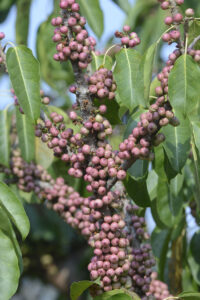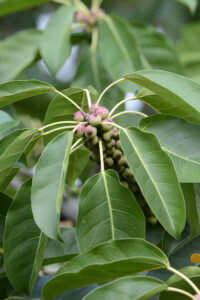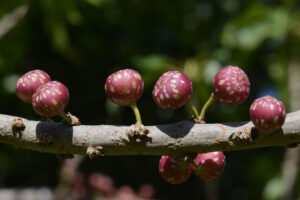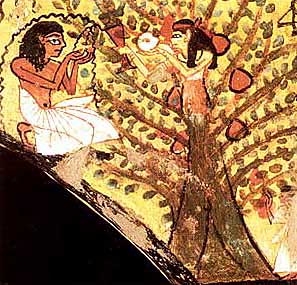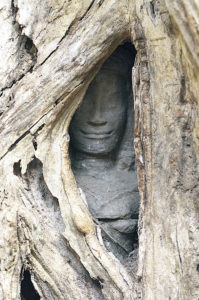Fig trees
Banyan (Ficus benghalensis) can grow to huge dimensions. In this picture, Ib Krag Petersen is standing beneath a very large specimen, encountered in Ranthambhor National Park, Rajasthan, India. (Photo copyright © by Kaj Halberg)
A huge sea fig (Ficus superba) next to a Daoist temple, Dongshih, south-western Taiwan. A few of its aerial roots have been permitted to remain. (Photo copyright © by Kaj Halberg)
Leaves and fruits of common fig (Ficus carica), Pamukkale, Turkey. (Photo copyright © by Kaj Halberg)
Huge fig tree of an unidentified species, blurred by morning fog, Ngorongoro Crater, Tanzania. (Photo copyright © by Kaj Halberg)
Another unidentified species, serving as part of a street restaurant in Hanoi, Vietnam. (Photo copyright © by Kaj Halberg)
Figs (Ficus) are a huge genus of about 850 species of trees, vines, or epiphytes, native throughout the tropics and subtropics, with a few species extending into warmer parts of the northern temperate zone.
One group of fig trees are the so-called strangler figs. Most seeds of these species begin their life as an epiphyte in a tree, the seed sprouting in a crack, or often in a pile of bird dung, delivered by the bird that ate the fig fruit. (The seed is not harmed by passing through the gut of the bird.)
Over the years, aerial roots of the young strangler fig grow down to the ground, where they take root, while other roots wrap themselves around and over time completely enveloping the host tree, which is eventually strangled to death. As its trunk decays, the fig tree is left as a hollow cylinder of aerial roots.
Many of the strangler figs not only grow on trees, they also very often sprouts in cracks on buildings. If they are left in peace, their roots will destroy the building.
Fig flowers are unique, hidden inside a syconium, a globular or pear-shaped receptacle with a very small opening, during which tiny fig wasps enter, belonging to various families in the superfamily Chalcidoidea. Each of these fig wasps only enter one species of fig.
Inside the syconium, the females lay eggs in sterile female flowers, which serve as food for the larvae. At the same time, they fertilize other female flowers with pollen, which was deposited on them just inside the opening, where the male flowers are situated. Later, the receptacle swells up, forming the fig, which contains many seeds.
The generic name is the classical Latin word for fig.
A species of strangler fig, strangling its host tree, Taitung Ecological Park, Taiwan. (Photo copyright © by Kaj Halberg)
Over the years, the host tree of this strangler fig in Ubud, Bali, Indonesia, was strangled to death, and when its trunk decayed, the fig tree was left as a hollow cylinder of aerial roots. (Photo copyright © by Kaj Halberg)
Fruits of an unidentified Ficus species, growing from numerous slender shoots on the lower part of the trunk, Lower Ghunsa Valley, eastern Nepal. (Photos copyright © by Kaj Halberg)
New leaves of an unidentified strangler fig, Taitung Ecological Park, Taiwan. (Photos copyright © by Kaj Halberg)
Food for animals
The fruits of many species are an important food item for many different animals, especially birds and bats.
I have observed many species eat the fruits, in Asia for instance blue-headed barbet (Psilopogon asiaticus), Taiwan-barbet (Psilopogon nuchalis), red-billed blue magpie (Urocissa erythrorhyncha), white-eared sibia (Heterophasia auricularis), rosy starling (Pastor roseus), common myna (Acridotheres tristis), Asian glossy starling (Aplonis panayensis), light-vented bulbul (Pycnonotus sinensis), Japanese white-eye (Zosterops japonicus), rhesus monkey (Macaca mulatta), and bonnet macaque (Macaca radiata).
In Africa for example red-eyed dove (Streptopelia semitorquata), African green pigeon (Treron calvus), violet-backed starling (Cinnyricinclus leucogaster), and superb starling (Lamprotornis superbus).
Light-vented bulbul (Pycnonotus sinensis), eating fruits of sea fig (Ficus superba), Central Taiwan Science Park, Taichung, Taiwan. (Photo copyright © by Kaj Halberg)
Rosy starling (Pastor roseus), feeding on fruits of banyan (Ficus benghalensis), Karnataka, southern India. (Photo copyright © by Kaj Halberg)
White-eared sibia (Heterophasia auricularis), feeding on fruits of sea fig (Ficus superba), Buluowan, Taroko Gorge, Taiwan. (Photo copyright © by Kaj Halberg)
African green pigeon (Treron calvus), feeding on fruits of an unidentied fig species, Ngorongoro Crater, Tanzania. (Photo copyright © by Kaj Halberg)
Japanese white-eye (Zosterops japonicus), eating fruits of sea fig (Ficus superba), Central Taiwan Science Park, Taichung, Taiwan. (Photo copyright © by Kaj Halberg)
Ficus auriculata Elephant-eared fig
This deciduous tree, by some authorities called F. oligodon, grows to 10 m tall, with a trunk diameter to 30 cm, and a large crown, bark grey and smooth, branches covered in bristles. The leaves are very large, long-stalked, alternate, thin, elliptic, to 45 cm long and broad, base rounded or heart-shaped, margin irregularly toothed, tip pointed, nerves prominent on the underside. Fruits are in stalked clusters on short branchlets from the trunk or thick branches, globular or sometimes pear-shaped, 2.5-9 cm across, initially green with white dots, dark red when ripe, with 4-6 weak longitudinal ridges.
It is distributed from north-eastern Pakistan and northern India eastwards to southern China, and thence southwards through Indochina to the Malacca Peninsula, but is often cultivated elsewhere. Its natural habitats include forests, shrubberies, and river banks.
The fruit is edible and sweet, and is used medicinally as a diuretic and a laxative, and to regulate digestion. The foliage is cut for fodder.
Strictly speaking, the specific name is derived from the Latin auricula (‘external ear’), but in a botanical context it mostly means ‘with two eared lobes near the base’, in this case alluding to the broadly heart-shaped leaf base. The alternative specific name is derived from Ancient Greek oligos (‘few’) and odous (‘tooth’), referring to the wide space between the teeth along the leaf margin.
The common name of course refers to the very large leaves.
Elephant-eared fig with fruits on a large branch, Landrung, Modi Khola Valley, Annapurna, central Nepal. (Photo copyright © by Kaj Halberg)
Ficus benghalensis Banyan, Bengal fig
This evergreen species is native to the Indian Subcontinent, but has become naturalized elsewhere, including Indochina and Australia.
It belongs to the strangler figs, but also often grows as a large free-standing tree, to 30 m tall. Hanging down from the branches are numerous aerial roots, which often take root, over time creating a ’forest’ of trunks, all of which are in fact a single individual. The world’s largest tree, by canopy coverage, is found in Kolkata, eastern India (see picture below).
The leaves are broadly ovate, very thick, to 30 cm long and 20 cm wide, the leaf-stalk may be to 7 cm long, but is often much shorter. The fruits are very small, to 2 cm across, orange or red at maturity.
Banyan is much utilized in traditional medicine. A decoction of the leaves is used to treat dysentery and diarrhoea, and a poultice made from young leaves is applied to abscesses. The latex is used to treat toothache, bruises, rheumatic joints, lumbago, and gonorrhoea, and, mixed with sugar, to treat dysentery in children. A decoction of the bark is tonic and diuretic.
The specific name is Latin, meaning ‘of Bengal’. Strictly speaking, Bengal is the lowland around the Ganges-Brahmaputra delta, but in the early period of British colonial India, the term ‘Bengal’ indicated a much larger portion of northern India.
Large banyan in morning light, Pokhara, Nepal. (Photo copyright © by Kaj Halberg)
This 250-year-old banyan in the botanical garden of Kolkata, eastern India, has grown to enormous dimensions and is the largest of its kind in the world. Its aerial roots have created an entire ‘forest’, which is in reality only a single tree. The central trunk (the mother tree) was removed in 1925 because of rot. When this picture was taken in 1994, there were c. 1,825 stilt roots, with a total circumference of c. 420 m and a height of c. 25 m. (Photo copyright © by Kaj Halberg)
Huge banyan with numerous aerial roots, near Rayagada, Odisha (Orissa), eastern India. (Photo copyright © by Kaj Halberg)
To Hindus, the banyan is a symbol of the mighty god Vishnu. Strings have been tied around the trunk of this sacred banyan in Kathmandu, Nepal, and an iron band has been wound around it, to which oil lamps are attached. Red dye and cloth have been placed at the tree as offerings. (Photo copyright © by Kaj Halberg)
Ficus benjamina Weeping fig
This evergreen species may grow to enormous dimensions, to 30 m tall, with a spreading crown and countless aerial roots. The twigs are drooping, which gave rise to its common name. The rather small, glossy leaves are short-stalked, ovate, to 10 cm long and 4 cm wide, with a wedge-shaped or rounded base and abruptly narrowed to a pointed tip, to 5 mm long.
The weeping fig is native to the Indian Subcontinent, eastwards to southern China and Taiwan, and thence southwards through Indochina and Indonesia to northern Australia, and eastwards to some of the Pacific islands.
In temperate areas, it is a very popular house plant, which can tolerate rather dry conditions.
The specific name is a corruption of the Hindi word banyan – a term used not only for the true banyan (F. benghalensis, above), but also to other large fig trees with aerial roots.
Giant weeping fig, Hanoi, Vietnam. (Photo copyright © by Kaj Halberg)
A row of old weeping figs, Tunghai University Park, Taichung, Taiwan. (Photo copyright © by Kaj Halberg)
This gigantic weeping fig grows near the Wenara Wana Temple (popularly called ‘Monkey Forest’), near Ubud, Bali, Indonesia. (Photo copyright © by Kaj Halberg)
A long-tailed macaque (Macaca fascicularis), walking up a thick stilt root of the same tree. (Photo copyright © by Kaj Halberg)
Lars Skipper, standing beneath a huge weeping fig with numerous aerial roots, called the ‘Thousand-root banyan’, Jhiben National Forest, eastern Taiwan. (Photo copyright © by Kaj Halberg)
Weeping fig, climbing up a tree and a building, Hanoi, Vietnam. (Photo copyright © by Kaj Halberg)
Exposed roots of a weeping fig outside the Hindu temple Pura Ulun Danu Bratan, Lake Bratan, Bali, Indonesia. (Photo copyright © by Kaj Halberg)
Red aerial roots of weeping fig, hanging over a road, Ubud, Bali. (Photos copyright © by Kaj Halberg)
Numerous aerial roots of a weeping fig, Sheding Nature Park, Kenting National Park, Taiwan. (Photo copyright © by Kaj Halberg)
Fruits of weeping fig, Taichung, Taiwan. (Photo copyright © by Kaj Halberg)
Fallen leaves, Taichung. (Photo copyright © by Kaj Halberg)
Fallen leaves and fruits, Central Taiwan Science Park, Taichung. (Photo copyright © by Kaj Halberg)
Incense sticks and vases with water have been placed at this weeping fig in Hanoi, Vietnam. (Photo copyright © by Kaj Halberg)
Ficus carica Common fig
One of the most famous Christian myths relates The Fall of Man. The text in Genesis, Chapter 3:1-7, reads as follows:
“Now, the serpent was more crafty than any of the wild animals the Lord God had made. He said to the woman, “Did God really say, ‘You must not eat from any tree in the garden’?”
The woman said to the serpent, “We may eat fruit from the trees in the garden, but God did say, ‘You must not eat fruit from the tree that is in the middle of the garden, and you must not touch it, or you will die’.”
“You will not certainly die,” the serpent said to the woman, “for God knows that when you eat from it your eyes will be opened, and you will be like God, knowing good and evil.”
When the woman saw that the fruit of the tree was good for food and pleasing to the eye, and also desirable for gaining wisdom, she took some and ate it. She also gave some to her husband, who was with her, and he ate it. Then the eyes of both of them were opened, and they realized they were naked; so they sewed fig leaves together and made coverings for themselves.”
These fig leaves were from the common fig, which has been cultivated for thousands of years in countries around the Mediterranean, which was presumably its original area of distribution. Today, no wild populations are known.
It is a small deciduous tree or large shrub, to 10 m tall, with smooth white bark. The leaves are large, to 25 cm long and 18 cm wide, with 3 or 5 deep lobes. The fruit is tear-shaped, to 5 cm long, intially green, which turns to purple or brown at maturity. The soft reddish or brown flesh is sweet-tasting and contains many tiny seeds. The fruits are eaten fresh or dried, or processed into jam or various types of desserts.
The common fig has also been used medicinally. The latex is a laxative, and the latex from unripe fruits was a remedy for warts and internal parasites.
The world production of figs was about 1.2 million tonnes in 2020, with Turkey, Morocco, Algeria, and Egypt as the largest producers.
The specific name is the feminine form of the adjective Caricus, a shortening of Caria and ficus (‘fig’), thus ‘the fig from Caria’, in Ancient Greek Karia, a Greek province in present-day south-western Turkey.
Common fig with unripe fruits, Kurşunlu, near Mudanya, Marmara Sea (top), and near Pamukkale, both in western Turkey. (Photos copyright © by Kaj Halberg)
These common figs have sprouted in an unusual place, among deposited calcium bicarbonate at the Pamukkale Terraces, Turkey. (Photo copyright © by Kaj Halberg)
Common fig may produce fruits quite far north, but only in sheltered places, like here in the town of Gudhjem, Bornholm, Denmark. (Photo copyright © by Kaj Halberg)
Ficus chirindensis
This strangler fig may grow into a massive tree, to 50 m tall, with numerous aerial roots. The leaves are spirally arranged, elliptic, oblong, or rounded, to 15 cm long and 7 cm wide, tip pointed, base heart-shaped, margin entire. Fruits to 4 cm across, greenish or pale yellow, with brown spots at maturity, in clusters up to 3 on short stalks on main branches.
It grows in montane evergreen forest at elevations between 700 and 1,600 m, from southern Kenya and eastern Zaire southwards through Tanzania, eastern Zimbabwe, and Malawi to Mozambique.
The specific name means ‘found in the Chirinda Forest’, a forest in eastern Zimbabwe. Presumably, the type specimen was collected there.
In this picture, I am standing inside a Ficus chirindensis, which has killed its host tree, leaving a hollow cylinder of aerial roots, Chirinda Forest, eastern Zimbabwe. (Photo Uffe Gjøl Sørensen, copyright © by Kaj Halberg)
Ficus erecta Japanese fig
This deciduous shrub or small tree, by some authorities known as F. beecheyana, grows to 7 m tall. The leaf-stalk is to 4 cm long, blade thin, variable, ovate, elliptic, oblong, or lanceolate, to 25 cm long and 10 cm wide, base rounded or slightly heart-shaped, tip long- or short-pointed. The fruit is globular or pear-shaped, long-stalked and often upright, to 2.5 cm across, yellowish, red, or purple when mature. It is edible and sweet.
It is native from north-eastern India and Bangladesh eastwards acroos northern Indochina to southern China, Taiwan, southern Korea, and Japan.
The tree is occasionally planted as an ornamental, and the bark fibres are used for making paper.
The specific name may apply to the fruit stalk, which is often erect.
Young leaves and fruits of Japanese fig, Mingtsih, central Taiwan. (Photos copyright © by Kaj Halberg)
Young leaves and fruits of Japanese fig, Yeliou Geopark, northern Taiwan. (Photo copyright © by Kaj Halberg)
Ficus lyrata Fiddle-leaf fig
This tree is native to lowland rainforest of western Africa, from Sierra Leone eastwards to Cameroun, but is widely cultivated as an ornamental tree in subtropical and tropical gardens, and as a houseplant in temperate areas.
It is usually rather low, to 15 m tall, but can reach 30 m in its native habitat. The crown is dense and rounded in mature trees, but rather sparse in young trees. The leaves are large, glossy, dark green, leathery, to 45 cm long and 30 cm wide, with prominent yellow veins on the upper surface and raised below, variable in shape, broadest towards the tip, often obovate, but sometimes with a narrow middle, resembling a lyre or a fiddle (hence its popular name), and often with wavy margins.
The fruit is globular, to 3 cm across, pale green with indented brownish dots. When drying out, they become very wrinkled.
Leaves and fruits of fiddle-leaf fig, Taichung, Taiwan. (Photo copyright © by Kaj Halberg)
Fallen, dried-out fruits, Taichung. (Photo copyright © by Kaj Halberg)
Ficus microcarpa Chinese banyan
An evergreen strangler fig, native from the Indian Subcontinent eastwards to Japan, and thence southwards through the Philippines, Indonesia, and New Guinea to eastern Australia and some western Pacific Islands. It is widely planted elsewhere and is regarded as an invasive species in Hawaii, Florida, Bermuda, and some Central and South American countries.
It may grow very large, the largest known specimen being in the Menehune Botanical Gardens, Kauai, Hawaii, which is about 33 m tall, with a crown spread of c. 75 m and more than 1000 aerial roots. The trunk can also grow very thick, the thickest known specimen being 8.5 m thick at breast height, found on Big Island, Hawaii.
The leathery leaves are short-stalked, ovate or elliptic, to 14 cm long and 9 cm broad, often with an abrupt, blunt tip, base narrowed or rounded. The fruits are stalkless, globular, to 1 cm across, green at first, later pink, red, or black.
Its natural habitats include forests, river banks, swamps, and mangroves, but it may also sprout in cracks on buildings.
Root, bark, and leaf latex are used medicinally to treat wounds, headache, toothache, colic, and liver trouble. The latex is also used for caulking boats. Formerly, fibres from the bark were made into cloth. The wood is used locally to make tools etc., and as fuel.
The specific name is derived from Ancient Greek mikros (‘small’) and karpos (‘fruit’).
Chinese banyans with stilt roots, Taitung Ecological Park, Taiwan. (Photo copyright © by Kaj Halberg)
Chinese banyan with aerial roots, Taichung (upper 2), and Jingliao, both Taiwan. (Photos copyright © by Kaj Halberg)
Chinese banyan with fruits, Taichung. (Photo copyright © by Kaj Halberg)
Fallen fruits and leaves, Taichung. (Photo copyright © by Kaj Halberg)
Ficus palmata
A deciduous shrub, or sometimes a tree to 10 m tall, bark brownish-grey, smooth, twigs densely hairy. The long-stalked leaves are very variable, ovate or rounded, often palmately lobed, to 14 cm long and 13 cm broad, toothed, rough above, woolly-hairy beneath. The fruit is solitary, sometimes in pairs, pear-shaped or globular, hairy, to 2.5 cm long, yellow or purple when ripe, often with 6-7 longitudinal ridges.
This species is widely distributed, found in north-eastern Africa, from Egypt southwards to Somalia, in southern Arabia, and from Iran and Afghanistan eastwards to western Nepal. It grows in forests, along streams, and on rocky slopes.
It is often cultivated. Young shoots are eaten as a vegetable. The ripe fruit is edible, and also used to ease constipation. The unripe fruit is poisonous, but edible after being boiled thoroughly. The latex is used for curdling milk, and medicinally to treat warts. The foliage is lopped for fodder.
The specific name is Latin, meaning ‘hand-shaped’, in a botanical context indicating a leaf with 3 or more lobes or veins, arising from the same point. Thus we learn that Pehr Forsskål (1732-1763), when he encountered this species in Yemen, named it from a plant with deeply lobed leaves. – Life and death of this excellent naturalist is described on the page People: Pehr Forsskål – brilliant Swedish scientist.
Ficus palmata with fruits, Neuli, Sainj Valley, Himachal Pradesh (top), and Lower Asi Ganga Valley, Uttarakhand, both in the Himalaya. (Photos copyright © by Kaj Halberg)
Ficus racemosa Cluster fig
A large, often deciduous tree, to 35 m tall, trunk to 90 cm in diameter, with buttresses, bark pale grey, smooth on younger trees, furrowed on older ones. The leaves are alternate, long-stalked, smooth, elliptic or ovate, to 20 cm long and 10 cm broad, tip pointed, margin often wavy, sometimes with a few weak teeth. The rounded or pear-shaped figs, to 4 cm across, grow in large bunches, to 30 cm long, on leafless, branched twigs, directly on the trunk or on older branches. They are initially pale green, later yellowish, orange-red, or reddish-brown when ripe.
This species is found from Pakistan, India, and Sri Lanka eastwards to southern China, and thence southwards through Indochina, Indonesia, and New Guinea to northern Australia, mostly growing in forests along streams, from sea level to elevations around 1,700 m.
The fruits are edible, often used in various preserves and side-dishes. Unripe fruits are pickled. The leaves are eaten as a vegetable, and also used as animal fodder. Medicinally, they are used against diarrhoea, and the root is chewed to treat tonsilitis.
Old cluster fig, Hanoi Botanical Garden, Vietnam. (Photo copyright © by Kaj Halberg)
Large cluster fig with numerous fruits, growing in the garden around the Tran Quoc pagoda, Hanoi. (Photos copyright © by Kaj Halberg)
Leaves of cluster fig, Tran Quoc pagoda. (Photo copyright © by Kaj Halberg)
Ficus religiosa Pipal, sacred fig
This species belongs to the strangler figs, not only growing on trees, but also very often sprouting in cracks on buildings, and even in pavements. It is deciduous or semi-evergreen, to 30 m tall and with a trunk diameter of up to 3 m. The leaves are very characteristic, long-stalked, heart-shaped, to 17 cm long and 12 cm broad, ending in a long, tapering point. The fruits are small, to 1.5 cm across, initially green, turning to red, purple, or black at maturity. They are arranged in clusters along branches and twigs.
Pipal is indigenous to the Indian Subcontinent and Myanmar, but as is sacred to Buddhists, Hindus, and Jainists, it is very commonly planted in areas dominated by these beliefs. Its sacredness is reflected in the specific name, as well as the English name. Pipal is its name in Hindi.
To Buddhists, it is known as the Bodhi Tree (’Tree of Enlightenment’). One day, around 500 B.C., a man, about 35 years old, was walking along a dusty road near the town of Gaya, northern India. For 5 years, he had been wandering the roads of northern India, searching for an answer to a question, which had bothered him for years: Why were people suffering?
Foot-sore, he sat down to rest in the shade of a huge pipal tree, determined not to leave, before he had found a satisfying answer to his question. For 49 days and nights he sat here, deep in meditation. Then he got up, convinced that he had found the answer.
From this day, he travelled about, preaching his new philosophy to a growing crowd of followers. His name was Siddharta Gautama, by his followers called The Buddha (‘The Enlightened One’). His life and teachings are described in depth on the page Religion: Buddhism.
Over the following centuries, a village named Bodhgaya sprung up around the pipal tree, beneath which Siddharta Gautama had obtained nirvana, and many Buddhist temples were built here. Today, thousands of pilgrims travel to Bodhgaya each year to revere a sacred pipal tree, which is said to be a direct descendant of the original Bodhi Tree.
In the Mahamewna Gardens in Anuradhapura, Sri Lanka, is another large pipal tree, which, according to devotees, is a direct descendent of the original Bodhi Tree. It is said that in 236 B.C., Emperor Asoka sent the Buddhist nun Sanghamitta Maha Theri to Sri Lanka, where she presented a branch of the original Bodhi Tree to King Devanampiya Tissa, who brought Buddhism to Sri Lanka. The king planted the branch in his Royal Park in Anuradhapura. The branch grew into a tree, later known as Jaya Sri Maha Bodhi, which is still alive today, thus being the oldest planted tree in the world.
This ancient pipal tree in Bandipur, central Nepal, has produced a huge branch, as thick as a medium-sized tree. (Photos copyright © by Kaj Halberg)
A row of planted pipal trees, illuminated by the morning sun, Taichung, Taiwan. (Photo copyright © by Kaj Halberg)
This pipal grows around a small Hindu shrine in Kathmandu, Nepal, causing it to crack. Over the years, it will destroy the building completely. (Photo copyright © by Kaj Halberg)
Pipal strangling roots, enveloping trunks of other trees, Hanoi, Vietnam. (Photos copyright © by Kaj Halberg)
This pipal has sprouted in a crack between a wall and a pavement, Hanoi. (Photo copyright © by Kaj Halberg)
In this picture, pipals have sprouted among roof tiles, Tran Quoc pagoda, Hanoi. (Photo copyright © by Kaj Halberg)
Pipal has broad, heart-shaped leaves, ending in a long, tapering point. – Taichung, Taiwan (top), and Pokhara, Nepal. (Photos copyright © by Kaj Halberg)
Withering pipal leaf, Taichung. (Photo copyright © by Kaj Halberg)
Figs of pipal, Taichung. (Photo copyright © by Kaj Halberg)
Fallen fruits, Taichung. (Photo copyright © by Kaj Halberg)
Buddhist monks, gathered in meditation in front of a sacred pipal tree in Bodhgaya, which, according to legend, is an offspring of the ancient Bodhi Tree (top). Other monks are prostrating in front of the tree. (Photos copyright © by Kaj Halberg)
The Jaya Sri Maha Bodhi Tree, Anuradhapura. (Photo copyright © by Kaj Halberg)
This sculpture beneath a sacred pipal tree in a Buddhist temple at Atanagalle, western Sri Lanka, depicts the meditating Buddha. (Photo copyright © by Kaj Halberg)
Sinhalese woman, watering another sacred pipal tree in a Buddhist temple at Kalutara, south-western Sri Lanka. (Photo copyright © by Kaj Halberg)
Ficus septica Septic fig, angular-fruit fig, white-veined fig
This is usually a shrub or a smallish tree, which may sometimes reach a height of 25 m. It is evergreen, leaves short-stalked, smooth, elliptic, ovate, or oblong, to 30 cm long and 15 cm wide, with prominent white or yellowish veins, base acute or rounded, tip pointed or rounded. The latex is yellow. The fruits grow along branches or from leaf axils. They are usually in pairs, but may be solitary or in small groups. They are short-stalked or nearly sessile, green, globular or ellipsoid, to 2.5 cm across, with 7-12 prominent longitudinal ribs, at maturity with numerous raised, whitish, yellowish, or brown dots, resembling small warts.
It is distributed at low altitudes, from the southernmost islands in Japan southwards through Taiwan, the Philippines, Malaysia, Indonesia, and New Guinea to extreme north-eastern Australia and some western Pacific islands.
The specific name alludes to the septic latex, which can be used externally to treat infections of the skin.
Leaf of septic fig, Tungling Forest, near Wufong, western Taiwan. (Photo copyright © by Kaj Halberg)
Leaves and fruits of septic fig, Siao Liouchou Island, southern Taiwan. (Photos copyright © by Kaj Halberg)
A cluster of fruits, Taipingshan National Forest, north-eastern Taiwan. (Photo copyright © by Kaj Halberg)
Ficus superba Sea fig, cedar fig
This magnificent tree grows to 30 m tall, with an umbrella-shaped crown. It belongs to the strangler figs, often growing on other trees or buildings, but is also able to thrive as a normal, free-standing tree.
The leaves are ovate with rounded or heart-shaped base, dark green and rather thin, to 20 cm long and 12 cm wide, with a slender leaf-stalk to 12 cm long. The leaves are shed regularly. The fruits are pinkish, red, or purple with white dots, arranged in large clusters along the branches.
It is native to Indochina, Malaysia, and Indonesia, but is often planted as an ornamental tree elsewhere, for instance in China, Taiwan, and Japan.
The pictures below were all taken in Taiwan, where this species is very commonly planted in city parks and around temples.
In Taiwan, this species is very commonly planted in city parks and around temples. This picture shows an ancient sea fig, growing in the park surrounding the Daoist ‘Temple of the Five Concubines’, from 1683, Tainan, southern Taiwan. (Photo copyright © by Kaj Halberg)
Daoist shrines beneath large sea figs, Tainan (top), and Yujing, both southern Taiwan. (Photos copyright © by Kaj Halberg)
Aerial roots of a giant sea fig have enveloped the remains of the former warehouse of Tait & Co., Anping, southern Taiwan. Today, the building is called Anping Tree House. (Photos copyright © by Kaj Halberg)
Aerial roots of an old sea fig have enveloped a large stone wheel outside the Daoist Longde Temple (‘Dragon Virtue’), Fenyuan, western Taiwan. (Photo copyright © by Kaj Halberg)
Aerial roots of a large sea fig, Shan Zhu Gou (‘Wild Boar Trench’), Siao Liouchou Island, Taiwan. The leaves in the background are elephant-ear taro (Alocasia macrorhiza). (Photo copyright © by Kaj Halberg)
Leaves and fruits of sea fig, Hanoi, Vietnam. (Photo copyright © by Kaj Halberg)
Fruits of sea fig, Central Taiwan Science Park, Taichung, Taiwan. (Photos copyright © by Kaj Halberg)
Ficus sycomorus Sycomore fig
This species is also known as sycamore fig, which is confusing, as the term sycamore usually denotes a species of maple, Acer pseudoplatanus, or various American plane trees (Platanus).
It grows to about 20 m tall, with spreading branches and a dense crown, the trunk to 2 m in diameter. The dark green, rather rough leaves are heart-shaped with a rounded tip, to 14 cm long and 10 cm wide, arranged spirally around the twig. The underside of the leaves is pale green with prominent yellow veins. The fruit is edible, to 3 cm across, initially green, yellow or red at maturity. They are borne in thick clusters on long branches and twigs, or in the leaf axils.
It is native to Africa south of the Sahel zone, southwards to Namibia, Botswana, and north-eastern South Africa, and also to southern Arabia. At a very early stage it was brought to Egypt, from where it spread to countries along the east coast of the Mediterranean.
The sycomore fig is mentioned several times in the Bible. In those days, it was widespread in Palestine, especially in the Jordan Valley, and it was often planted along roads to provide shade.
In Luke 19:4-6, it is said about the tax collector Zacchaeus, who was a small man, that he climbed a sycomore fig to have a better view of Jesus who was passing through Jericho: “And he ran before, and climbed up into a sycomore tree to see him: for he was to pass that way. And when Jesus came to the place, he looked up, and saw him, and said unto him: “Zacchaeus, make haste, and come down; for today I must abide at thy house.” And he made haste, and came down, and received him joyfully.”
The wood of the sycomore fig is durable and was used as timber, especially for ceiling and roof construction. In Ancient Egypt, due to its resistance, it was used to make sarcophagi, furniture, and statues, and to build ships. It was also widely utilized medicinally in Egypt. The fruits were used to treat wounds, ulcers, and bone injuries, the juice for burns and open wounds.
The sycomore fig was sacred in Egypt, regarded as a manifestation of the goddesses Isis, Nut, and Hathor. Isis was the mother goddess, an expert physician and sorceress, Nut was the sky goddess, and Hathor was sky goddess as well as goddess of the underworld. Like many other fig species, the sycomore fig contains milky latex, and this is the reason that it was connected with these important goddesses. The latex was seen as a symbol on the power of the mother goddess, transferred to the people.
This species was also sacred to the Kikuyu people of East Africa, and all sacrifices to the supreme creator Ngai were performed beneath it.
The specific name is derived from Ancient Greek sykon (‘fig’) and moron (‘mulberry’), alluding to the fruits resembling mulberries.
Two of the Egyptian goddesses in a sycomore fig. – Painting in the tomb of Pashedu, Valley of the Kings. (Public domain)
At dusk, the sky goddess Nut swallows the sun, and during the night it wanders through her body, to be reborn at dawn. – Painting on the ceiling in the tomb of Rameses VI, Valley of the Kings. (Photo copyright © by Kaj Halberg)
Ficus tinctoria Dye fig, humped fig
A large evergreen strangler fig, to 25 m tall, with a spreading crown, and a trunk up to 3 m across. The short-stalked leaves are elliptic, ovate, or oblong, to 13 cm long and 6.5 cm wide, tip and base blunt-pointed or rounded, margin entire and often wavy. The fruits are globular, solitary or paired, very short-stalked, growing in the leaf axils, to 1.7 cm across. Initially they are green, later becoming yellow, orange, dull red, purple, or rusty-brown.
This species is found from the Indian Subcontinent eastwards to southern China, and thence southwards through Indochina, Indonesia, the Philippines, and New Guinea to eastern Australia and many islands in the Pacific.
The fruits are edible and constitute as a major food source in Micronesia and Polynesia. Medicinally, a decoction of the leaves is used as a dressing for broken bones. Ropes are made from fibres of the bark.
The specific name is Latin, meaning ‘to dye’, alluding to the traditional usage of root and fruits to produce red and scarlet dyes.
The gnarled base of the trunk of a dye fig of the subspecies gibbosa, which is strangling a silk-cotton tree (Bombax ceiba), photographed among the Khmer ruins at Angkor Wat, Cambodia. (Photo copyright © by Kaj Halberg)
Another specimen of the subspecies gibbosa has strangled a tree, which is growing on a ruin, Ta Prohm, Angkor Wat. (Photo copyright © by Kaj Halberg)
Dye figs also readily grow on buildings, as this huge specimen, embracing a ruin at Ta Prohm. Several pictures from these impressive ruins are found on the page Decay. (Photo copyright © by Kaj Halberg)
In Hinduism, apsaras are supernatural female beings, superb in the art of dancing. They are often depicted dancing to music, delivered by Gandharvas, court musicians of the rain god Indra. They entertain and sometimes seduce gods and men. Over time, this Khmer sculpture at Ta Prohm, which probably depicts an apsara, has been almost completely enveloped by a huge dye fig. (Photo copyright © by Kaj Halberg)
(Uploaded October 2023)
(Latest update February 2024)
